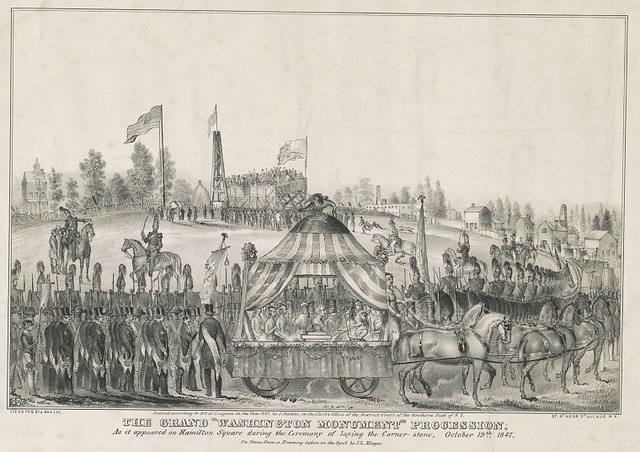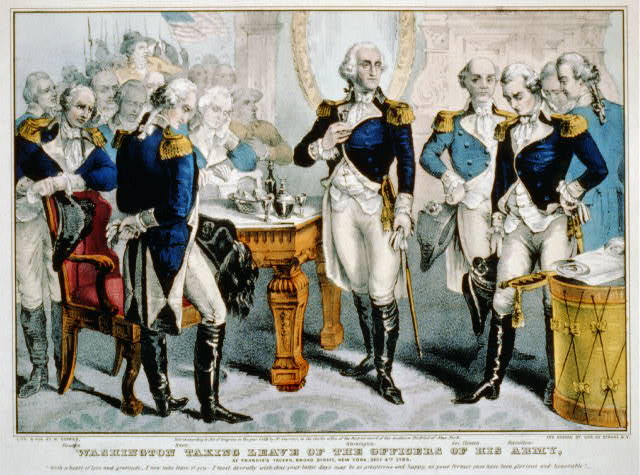 “The Grand Washington Monument Procession.” Via Library of Congress Prints and Photographs Division. Image by James S. Baillie.
“The Grand Washington Monument Procession.” Via Library of Congress Prints and Photographs Division. Image by James S. Baillie.
On Tuesday, October 19, 1847 thousands attended a ceremony in New York’s Hamilton Square (a lost public square on the Upper East Side) to celebrate the laying of the cornerstone for a 425-foot tall Washington Monument. However the monument was never constructed and the fate of the cornerstone remains uncertain.
On that morning, which was the anniversary of the British surrender to Gen. George Washington at Yorktown, a procession marched from City Hall in Lower Manhattan a distance of over four miles to Hamilton Square on the then rural Upper East Side.
The New-York Daily Tribune estimated the ceremony’s crowd at 250,000, a high number considering the city’s population was about a half-million at the time. Nevertheless, all accounts describe large crowds.
 GW in NYC: “Washington taking leave of the officers of his army: Fraunces’ Tavern, Broad St., New York, Dec. 4, 1783.” Via Library of Congress Prints and Photographs Division. Image by N. Currier, ca. 1848
GW in NYC: “Washington taking leave of the officers of his army: Fraunces’ Tavern, Broad St., New York, Dec. 4, 1783.” Via Library of Congress Prints and Photographs Division. Image by N. Currier, ca. 1848
This day had been long in coming. A group had been founded in 1833 to create a memorial to George Washington. After years of little action, the city and the Washington Monument Association of the City of New York chose a site and design. It would be paid for by public donations.
The design by Calvin Pollard, one of the architects of Brooklyn Borough Hall, was a Gothic-style tapered granite tower to be placed on a hill in the large public square. The plans included a library and other spaces on the ground floor and an observatory above. It dwarfed New York’s tallest building, the 284-foot tall Trinity Church, completed the year before, and was intended to be visible from 50 miles away.
However, reactions to the monument’s design were mixed.
The New York Herald declared it would be “one of the most splendid Monumental Edifices ever.” In contrast, the New York Evening Express argued “in order to make it a Washington Monument, there should be something whereby the stranger could be enabled to recognize it as such.”
 An earlier iteration of Pollard’s design. New-York Daily Tribune, 17 August 1843
An earlier iteration of Pollard’s design. New-York Daily Tribune, 17 August 1843
The New York Sun was blunter: “New York will shame herself and the memory of Washington be desecrated by any tinselly Gothic structure and we pray in common with thousands that the corner stone now laid for a Gothic spire will be left to lie alone forever.”
The Sun got its wish.
Fundraising did not succeed, construction did not move forward, and New York’s Washington Monument soon faded from public consciousness. Hamilton Square was developed, not as a park, but with a mix of private and public buildings.
In the nation’s capital, meanwhile, construction on the Washington Monument on the National Mall started less than a year after New York’s cornerstone ceremony on July 4, 1848 and was completed in 1884.
What became of the cornerstone?
An 1879 New York Herald article stated that the cornerstone was incorporated into the foundation of Mount Sinai Hospital constructed at Lexington Avenue and E. 67th Street in 1872. That building was demolished after the hospital moved to its present location in 1904 and replaced by apartment buildings.
Alternatively, a widely published news article in 1890 stated that Terrence Farley, an alderman with links to Tammany Hall, received a city contract in 1867 to level the grades of the old Hamilton Square and is suspected of removing the cornerstone when he flattened the hill on which it sat. The article concluded, “no man knoweth of its location to this day… Is it not a ludicrous outcome for a great city enterprise? And slightly humiliating?”
New York eventually created other monuments to Washington, including an equestrian statue in Union Square and the arch in Washington Square, but the plan for the original monument and its missing cornerstone are mostly forgotten.
Next, read about the lost Hamilton Square and top 10 secrets of Washington Square.





